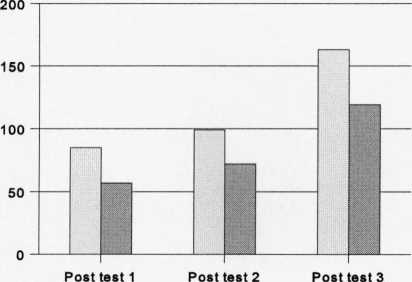шяшш
Is children ,s performance on the naming task influenced by the semantic domain of the
lexical items ?
By considering all the children together there were 260 responses for the words describing
animals and 260 responses for the words describing artifacts. Figure 7.3 shows that all the
children performed better on the naming task if the target word was describing an animal
than an artifact. The differences were significant across testing (Wilcoxon: Pl: Z=3.5,
p<.0005; P2: Z=3.2, p<.005; P3: Z=3.8, p<.0005). The same pattern was also evident in the
pre-test (t=9.08, df=129, p<.000).
Figure 7.3 Total number of correct responses on the naming task by semantic domain
across testing

] Animals Γj Artifacts
The same pattern was also found for the Phonological control group during post test 3
(Wilcoxon: Z=2.7, p<.005) the Lexical contrast (Wilcoxon: Pl: Z=3.05, p<.005; P2: Z=3.05,
p<.005; P3: Z=3.4, p<.005); and Definition group across testing (Wilcoxon: Pl: Z=2.9,
p<.005; P2: Z=2.03, p<.05; P3: Z=2.8, p<.005). No significant differences were found for
the Control and the Ostensive Definition group. A “floor effect” was evident for those
groups.
To what extent does the child’s prior lexical knowledge2 (comprehension and naming)
influence performance on the naming task c!
Children with high level naming vocabulary performed significantly better on the naming
task than children with low naming vocabulary across testing (Mann-Whitney U: Pl: Z=2.1,
2 Children’s prior lexical knowledge was the score they achieved in the pre-test (naming
and comprehension) with the target lexical items removed
200
More intriguing information
1. Detecting Multiple Breaks in Financial Market Volatility Dynamics2. The economic value of food labels: A lab experiment on safer infant milk formula
3. Weather Forecasting for Weather Derivatives
4. On Dictatorship, Economic Development and Stability
5. Luce Irigaray and divine matter
6. Smith and Rawls Share a Room
7. IMMIGRATION AND AGRICULTURAL LABOR POLICIES
8. The name is absent
9. The name is absent
10. Expectation Formation and Endogenous Fluctuations in Aggregate Demand